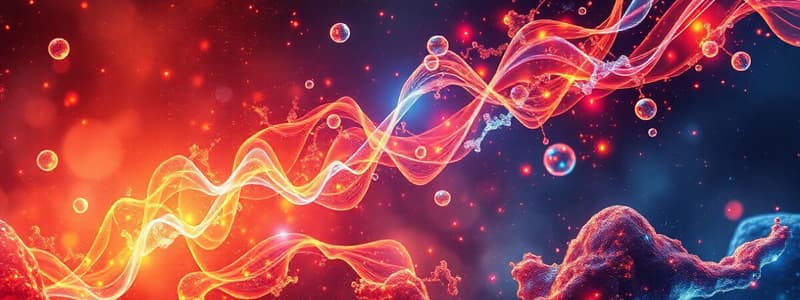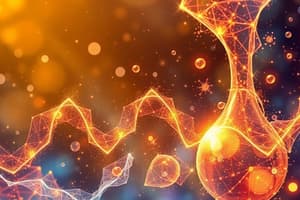Podcast
Questions and Answers
What does the half-life period of a reactant signify?
What does the half-life period of a reactant signify?
- The time required for the initial concentration of the reactant to be reduced to a quarter.
- The total time required for a reaction to complete.
- The time required for the initial concentration of the reactant to be reduced to half its value. (correct)
- The time taken for the reactant to fully decompose.
What happens to the rate constant of a chemical reaction when the temperature is increased by 10 °C?
What happens to the rate constant of a chemical reaction when the temperature is increased by 10 °C?
- It remains constant.
- It accelerates exponentially.
- It nearly doubles. (correct)
- It decreases significantly.
What is the temperature coefficient of a reaction?
What is the temperature coefficient of a reaction?
- The ratio of the rate constants of the reaction at two temperatures differing by 10 °C. (correct)
- The ratio of the rate constants at two temperatures differing by 15 °C.
- The time taken for the reaction to reach equilibrium.
- The change in enthalpy of the reaction.
In the Arrhenius equation, K = Ae^(-Ea/Rt), what does 'Ea' represent?
In the Arrhenius equation, K = Ae^(-Ea/Rt), what does 'Ea' represent?
Which of the following theories is NOT associated with reaction rates?
Which of the following theories is NOT associated with reaction rates?
What does the rate of reaction express in a chemical process?
What does the rate of reaction express in a chemical process?
What is the unit of measurement for the rate of reaction?
What is the unit of measurement for the rate of reaction?
In a first order reaction, what defines the rate law?
In a first order reaction, what defines the rate law?
What is the significance of the rate constant 'k' in chemical kinetics?
What is the significance of the rate constant 'k' in chemical kinetics?
How is the order of reaction defined?
How is the order of reaction defined?
Which of the following statements is true regarding zero order reactions?
Which of the following statements is true regarding zero order reactions?
What is the maximum value for the modularity of a reaction?
What is the maximum value for the modularity of a reaction?
Which type of reaction is characterized by a rate law that corresponds to a sum of powers equal to two?
Which type of reaction is characterized by a rate law that corresponds to a sum of powers equal to two?
Flashcards are hidden until you start studying
Study Notes
Chemical Kinetics Overview
- Chemical kinetics studies the rates of chemical reactions, factors affecting these rates, and reaction mechanisms.
- Key focus includes understanding how reaction rates change over time and under various conditions.
Rate of Reaction
- Defined as the change in concentration of reactants or products per unit time; typically expressed in mol L⁻¹ s⁻¹.
- For the reaction A + B → C, the rate is indicated as a decrease in concentration of A and B over time.
- Reaction rate is variable and generally decreases as the reaction proceeds, except in zero-order reactions.
Rate Law
- A rate law describes the mathematical relationship between reaction rate and the molar concentrations of reactants.
- The order of reaction with respect to each reactant is represented by exponents (m and n), with m + n indicating the overall order.
- It can vary and may include fractions, zeros, or whole numbers.
Rate Constant
- The rate constant (k) reflects the rate of reaction when concentrations of all reactants are at unity.
- Also known as the specific reaction rate or velocity constant.
Reaction Order and Modularity
- The order of a reaction represents the sum of the exponents in the rate equation and can be zero or fractional.
- Modularity refers to the number of particles involved in an effective collision that results in a reaction; can only be whole numbers and never exceeds three.
Types of Reactions
- First Order Reactions: Reaction rate depends on the concentration of one reactant.
- Second Order Reactions: Sum of powers of concentration terms in the rate law equals two.
- Zero Order Reactions: Reaction rate remains constant regardless of reactant concentration; represented as Rate = k[A]⁰[B]⁰.
Half-Life
- Defined as the time taken for the concentration of a reactant to decrease to half its initial value.
Temperature Effects
- An increase of 10 °C typically doubles the rate constant for a chemical reaction.
- The temperature coefficient relates the rate constants at two temperatures differing by 10 °C, typically measured at 25 °C and 35 °C.
Arrhenius Equation
- Represents the effect of temperature on the rate constant: K = Ae^(-Ea/RT), where A is the frequency factor and Ea is the activation energy.
- This equation helps correlate rate constants at different temperatures.
Theories of Reaction Rates
- Two primary theories are used to explain reaction rates:
- Collision theory, focusing on particle collisions.
- Transition state theory, focusing on the temporary state during a reaction.
Studying That Suits You
Use AI to generate personalized quizzes and flashcards to suit your learning preferences.




